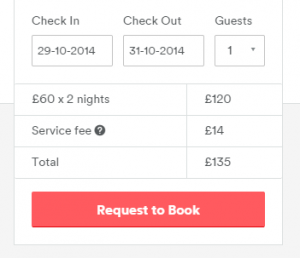Carebnb – 4 lessons learned from the Airbnb ebola spoof
29 October 2014 | Estimated reading time: 3 minutes

In a very strange move this is my second blog post in as many days about a non-profit spoof Airbnb website. My post yesterday looked at lessons learned from Barnardo’s interesting #Carebandb campaign. Their campaign highlights the often squalid living conditions many care leavers face. One of my major concerns with the campaign was the fact that we’ve already seen a charity Airbnb spoof this month – #Carebnb.
Confused much? I was.
Founded by two social entrepreneurs, #Carebandb #Carebnb invites users to ‘book a night’ in one of Carebnb’s hosted accommodations. You’re actually donating a night of care and treatment on behalf of someone affected by the ebola virus in countries where care is limited, medical volunteers lack training and basic necessities are severely lacking. Run by The Believe.in Trust, 100% of your donation through Carebnb is re-granted to Médecins sans Frontières, first responders combating the virus. Funds will go towards helping them replenish supplies, train staff and deploy more tents to serve rapidly increasing numbers of victims.
So what are the fundraising, campaigning and social media lessons learned from this campaign?
1. Mix real stories with spoof content to give maximum impact

Carebnb listing pages serve to show the stark differences between treatment facilities in the US and Spain versus those in West Africa. The reviews, real verbatim quotes from press interviews, highlight significant problems such as accessibility, capacity constraints, lack of information, healthcare revolts and economic & social isolation. These real-life snippets hammer home the reality of the situation. All the photos and names of hosts and reviewers have been purchased from stock photography libraries or are licensed under creative commons. This mix of real stories with spoof content works incredibly well.
2. Don’t just focus on the ’cause’ – think about the individuals involved

One of the features that excited me the most was the opportunity to learn more about my ‘hosts’ – the doctors and nurses fighting ebola. The problem is when I click on Marco or James & Camilla’s profiles on the front page I’m simply taken in to one of the five spoof listings. This is a minor criticism but the user-experience could have been much richer and I could have learnt more about the treatment process had those links clicked through to Airbnb-style host profiles of those nurses and doctors.
3. Social media shouldn’t be an afterthought
One of my criticisms of the Barnardo’s Carebandb site was the lack of social sharing options anywhere on the site. While Carebnb manages to fit in a Like, Tweet and G+ Share bar at the top of each page, the message you’re prompted to share is generic (see below). It would have been great if pre-populated share text was tied in to individual listings on the site. For example, if I’m on the Sierra Leone page then my tweet might read ‘check out this incredible Sierra Leone listing on #Carebnb http://www.carebnb.io/rooms/sierra-leone’.
Book a night at an incredible http://t.co/hNWzfYInmQ location and save a life. @Carebnb #carebnb #fightebola
— Ross McCulloch (@ThirdSectorLab) October 29, 2014
4. Taking action needs to be incredibly simple

One of my favourite elements of the site is that big red ‘donate now’ button (below). It is virtually a carbon copy of the ‘request to book’ button on Airbnb (above). Working in tandem with the spoof listing page itself you feel compelled to click. The button is well placed and the donation process is incredibly simple.

Anything I’ve missed? I’d love to hear your thoughts on the Carebnb campaign.
Speak to us about developing a spoof website for your next campaign.






